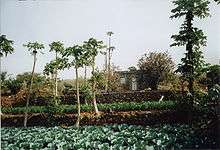Agriculture in Cape Verde
Agriculture in Cape Verde is an industry that has plenty of potential.
Crops

The most widespread agricultural activity of the Cape Verde islands is gardening for domestic consumption. Garden crops include corn, cassava, sweet potatoes, and bananas. Only about 11.2 percent of the land area is suitable for crop production. Frequent droughts often exacerbate an ongoing water shortage. Agriculture employed about 21% of the active population and contributed 15 percent to GDP in 2003. Estimated 2004 production figures were sugarcane, 14,000 tons; corn, 14,000 tons; bananas, 6,000 tons; coconuts, 5,000 tons; mangoes, 4,500 tons; cassava, 3,000 tons; and potatoes, 3,500 tons. Only the islands of São Tiago, São Vicente, São Nicolau, Fogo and Santo Antão have conditions suitable for raising cash crops. Bananas, almost the only agricultural export, are grown on irrigated land. On Fogo, wine and coffee are grown for export: In 2008, 108 t of grapes where harvested on an area of more than 200 ha.[1] In 2008, 21 t of coffee were harvested on Fogo after 35 t in 2006 and 45 t in 2007.[2] Sugarcane, another cash crop, is used on the islands to produce rum. The chief rum growing areas are Ribeira do Paul and Ribeira Grande valleys of Santo Antão and Ribeira Grande de Santiago and Ribeira Principal on Santiago.
Development
Agriculture has been the focus of development aid programs since the 1960s, but progress has been frustrated by drought, locusts, overgrazing, and archaic cultivation methods. Approximately 85–90 percent of food needs are met by imports; agricultural imports had a value of $112.8 million in 2004.
History
Agriculture during Portuguese control
Agriculture began when after Cape Verde was first inhabited in 1461 with the founding of Cidade Velha on Santiago. Bananas, sugars, cocoa and mangoes were first planted from the Old World Mainland, brought by the Portuguese and were grown and harvested by the slaves and were mostly exported to Portugal. Later, cattle including cow, sheep and goat were brought into Cape Verde from Europe and expanded livestock production on Maio and later to other islands as well as Boa Vista. In the 16th century, potatoes, sweet potatoes, papayas and other tropical crops from the Americas were brought into the islands which later included corn (maize). Agriculture continue to flourish with deforestation and land replacement from scrublands and shrublands, Boa Vista and Sal at the time had a few scrublands. Around 1794, Cotton started to be produced in the island of Santiago and later most of the archipelago.
Agriculture in Cape Verde during Portuguese rule was hit hard with droughts starting in the mid-18th century which was led by deforestation alongside climate change which temperatures later slightly risen a few degrees from that time in two centuries. Agriculture was hit hard but rarely in tropical fruits and vegetables. In the island of Fogo, all livestock on the island including cows, sheep and goats, disappeared until around the 19th century. Famine conditions worsened in the mid 19th century, hard hit were Boa Vista, Maio, Santiago and Fogo. Santiago that time were struck by famines in 1831 and 1855. Agriculture went up and down during that time and later dropped before the Great Depression when agriculture was predominantly crippled. Also less land were used for agriculture in Boa Vista, Fogo and Maio. Agriculture steadily regained in the 1960s but not as much as to food imports.
Land reform
The African Party for the Independence of Guinea and Cape Verde (PAIGC) nationalized a few large-scale irrigated agricultural operations and began a program of land reform and cooperative agriculture; sharecropping was abolished. During 1976–80, 7,200 rainwater dikes were built. Torrential rains in 1984 destroyed much of this work, but by 1986, 17,000 dikes and 25,000 stone retaining walls had been completed. There has been little land redistribution, despite a 1982 law distributing farms over five hectares (12.5 acres)—1 hectare (2.5 acres) if irrigated—among the tenants if the land is not directly farmed by the owners.
Modern history
Hurricane Fred in 2015 devastated parts of the country's agriculture. Much of the damage was done in the eastern part of the island of São Nicolau and the area of Alto Mira on Santo Antão Island. On São Nicolau Island, much of the island's livestock was lost in the storm.[3] Damage to homes and the agriculture—in particular banana and sugarcane[4] on São Nicolau totaled 30 million escudos (US$305,000). Carrot, cabbage, and tomato plantations were destroyed in the village of Alto Mira in the island of Santo Antão.[5] Nonetheless, rainfall from Fred had a generally positive effect on the larger-scale agriculture of the islands, refilling many rivers and dams and irrigating drought-stricken farmland across the Sotavento region.[6] Many of these has been recovered as of Spring 2018.
See also
References
- ↑ Pitt Reitmeier: Cabo Verde, p.394. Bielefeld 2009.
- ↑ Susanne Lipps: Kapverdische Inseln, p. 262. Ostfildern 2009
- ↑ "Ministra do Desenvolvimento Rural São Nicolau para se inteirar dos estragos causados pelo furacão "Fred"". Inforpress CV, Associated Press (in Portuguese). Praia. 2015-09-07. Archived from the original on 2015-10-01. Retrieved 2015-09-20.
- ↑ "Agricultores de Fajã somam prejuízos com passagem do furação Fred". Ocean Press (in Portuguese). Santa Maria, Cape Verde. 2015-09-01. Archived from the original on 2015-10-01. Retrieved 2015-09-21.
- ↑ "Santo Antão: Agricultores de Alto Mira querem apoio do MDR para compensar estragos nas culturas". Inforpress CV (in Portuguese). Praia. 2015-09-09. Archived from the original on 2015-10-01. Retrieved 2015-09-21.
- ↑ "Chuvas fazem transbordar barragens de Faveta e de Canto de Cagarra" [Rainfall Filled Up the Dams of Faveta and Canto de Cagarra]. A Semana (in Portuguese). Praia. 2015-09-02. Archived from the original on 2015-09-14. Retrieved 2015-09-20.
![]()